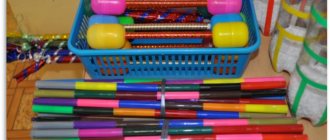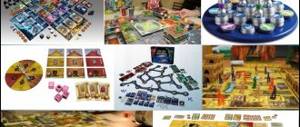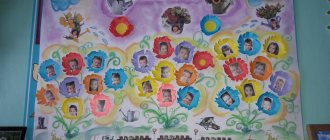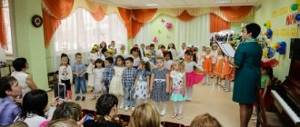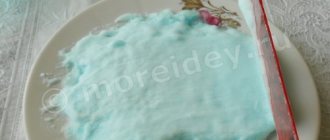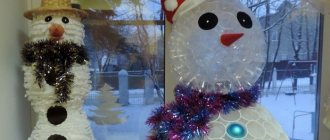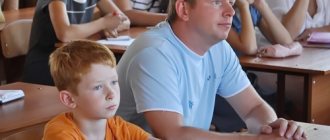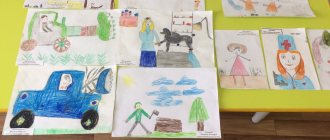DIY sports equipment - how to make dumbbells for children
They can be made from the most unusual materials.
Take:
- imunele bottles;
- wooden sticks;
- scotch;
- peas.
Unscrew the bottle caps. Insert wooden sticks into each pair to connect these containers in pairs. Wrap with tape around the necks. But first, pour dry peas or beans into the bottles. You can also use buckwheat, rice.
Such sports equipment for kindergarten will help children fall in love with sports, they will be able to develop the strength of their hands.
You can also use unnecessary skittles to make dumbbells. You will make slits on the side of the neck, put loose weights in them and connect these parts in pairs with tape or tape.
If you want to make sports equipment for children, you can also take regular plastic bottles with a volume of 300 or 500 ml. And for adults, you will use larger bottles.
- See also how to make a climbing wall for children in the country
How to make checkboxes
Do-it-yourself sports equipment for kindergarten in the form of signal flags will be useful for holding any competitions. Making them is as easy as anything else. To create them, a bright piece of fabric and small wooden sticks (can be replaced with food skewers) are suitable. They will be rectangular in shape. It is enough to cut a piece of fabric and hem it by hand on three sides. From the last end you need to make a loop along the entire length for the stick. After this, the sticks are inserted. The flags are ready! They are placed on the sides of the treadmill to indicate a path or turn. They are very functional, so they will come in handy everywhere.
We train the eye - do-it-yourself sports equipment
A ring throw will help with this. Take:
- plastic bottles with a volume of 1.5 to 2.5 liters;
- colored electrical tape;
- cardboard;
- scissors;
- glue.
Making master class:
- Cut out rings from cardboard. If you don't have very thick pressed paper, then connect the two rings in pairs.
- When the glue is dry, wrap them with colored electrical tape. Take plastic bottles, remove the labels from them, fill them with loose grain or sand so that these blanks are stable.
- Now invite the children to split into two teams and take turns throwing their rings at a certain bottle. Those who can string the most rings will win.
And here is another game called “Hit the Target.” It will also help train your eye. Also, the child will be able to develop coordination of movements, manual dexterity, speed of reaction, and attention. Take:
- thick fabric;
- scissors;
- threads;
- ball.
Making master class:
- Fold the fabric in half and stitch along the edges. Then place the ball here. See what size the holes need to be made so that this sports attribute fits into the grooves made.
- This game requires four people. Each of them will take a corner of the fabric at the base. The ball is placed in the center.
- Now the children need to throw it, but not high, so that the ball then falls into some hole. Here some of them will give up, others will take action in order to direct the projectile straight to the target.
Also, other sports equipment for kindergarten will help develop the children's eye. Cut out various shapes from cardboard. These can be rectangles, circles, triangles. Cover with self-adhesive film or cloth. Make a hole at the top to thread a thick rope through. Hang this attribute. Let your child throw objects, such as balls, inside. This way he will develop dexterity of movements.
Non-traditional equipment to increase physical activity of children
Non-traditional equipment to increase physical activity of children
Relevance
Having analyzed the independent activities of children, I concluded that most children experience a “motor deficit,” that is, the number of movements they make during the day is below the age norm. In addition, children find it difficult to organize their activities, which also adversely affects their physical activity. Children find something to do, taking into account their interests, but they still cannot diversify their activities. In many ways, children's mobility depends on their motor skills. There is a need for organized motor activity
Problem
How to increase children's physical activity?
Novelty
The use of health-saving technologies in organizing the group’s daily motor activity based on the principle of taking into account the age and individual characteristics of preschool children
Target:
Development of motor abilities of preschool children through the organization of a motor regime that helps satisfy the natural need of each child for movement
Tasks
Understanding the importance of the problem of increasing children’s motor activity, several tasks were put forward:
- increase physical activity of children;
- create optimal conditions for each child in the process of mastering motor experience;
- increase children's interest in various types of motor activities;
to cultivate in children a conscious attitude towards performing motor actions.
"Magic rug"
Material: This equipment is made of plastic bottles with caps based on drape fabric.
Purpose: Designed for walking barefoot, correcting and preventing flat feet, hardening. It is used for physical exercises, during gymnastics, and joint sports events with parents.
"Breeze in a Bottle"
Material: This manual is made from a plastic bottle, colored paper, and cocktail straws.
Purpose: Used for breathing exercises. Develops respiratory organs.
"Sultans"
Material: Made from sticks and colored ribbons, ribbons.
Purpose: Designed for performing general developmental exercises, breathing exercises, organizing outdoor games, competition games. Promotes the development of respiratory organs and trunk muscles.
"Bilboke"
Material: Made from plastic bottles, fishing line, Kinder Surprise capsules, for decoration: colored adhesive paper.
Target: Designed to hit a target. Develops eye, attention, reaction speed, manual dexterity.
"Expander"
Material: Made from five-liter plastic canisters and elastic.
Purpose: Designed to develop strength.
"Dumbbells"
Material: Made from plastic bottles, colored tape and sand (or other material for filling them).
Purpose: Designed to develop strength.
"Colorful balls"
Material: Made from small plastic bottles, filled with colored rain, candy wrappers, etc.
Purpose: Designed to perform general developmental exercises, basic types of movements, massage and self-massage, prevention of flat feet, development of fine motor skills, used as substitute objects for role-playing games.
"Tunnel"
Material: Made of aluminum hoop and thick fabric.
Purpose: Designed for climbing. Used in outdoor games, when performing basic types of movement, in role-playing games.
"Walkers"
Material: Made from painted wooden blocks and clothesline.
Purpose: Designed to perform basic types of movement, to develop movement coordination, and for independent play activities.
"Sports bags"
Material: Made of thick fabric and filled with beans, you can use other filler (small pebbles, beads, peas, etc.)
Purpose: Designed to perform general developmental exercises, basic types of movements, massage and self-massage, and prevention of flat feet.
Thank you for your attention !
Homemade exercise equipment for outdoor games with your own hands
You can make these in a matter of minutes. Take a rope and tie it in some places with colored electrical tape.
Now you can use it to come up with a variety of outdoor games. Tie a rope low and let the kids step over it first. Then position the rope higher so they crawl under it.
The following sports equipment for kindergarten, created with your own hands, will help children develop coordination of movements.
Take:
- thin foam;
- thick dark fabric;
- multi-colored rags.
First, take scraps of colorful fabric and cut out numbers from them.
It is better to take a canvas whose edges do not crumble. Fleece or drape is perfect.
Cut a rectangle out of foam rubber. Two of the same, but a little larger, will need to be made from fabric. But it is more advisable not to cut these two rectangles, but to make one large one. Fold it in half. Topstitch along the edges. Leave free edges on one side to insert foam rubber here. Straighten the workpiece and sew it here on your hands.
Now you can lay out this rug. Give your child different tasks, for example, step on the numbers in order or in reverse order. You can arrange real fun competitions if there are two participants.
How to make sports equipment for kindergarten - interesting attributes
See also how you can make various sports equipment from improvised materials. These are called belboks. To make such sports equipment for children, take:
- laces or ropes;
- plastic bottles;
- plastic boxes from Kinder surprises;
- soft fabric;
- electrical tape;
- threads;
- markers.
Making master class:
- First, cut the plastic bottles. Now draw different flowers here with markers. To prevent children from getting hurt, cover the cut areas with fluffy cloth. You can use an old terry towel as it.
- Use a hot nail to make a hole in the middle of each lid, insert a cord here, and tie the end of it in a knot so that the laces are fixed.
- Attach them to the chocolate egg containers in the same way. Make a hole in this plastic with a hot nail, thread the lace and tie it with a knot on the back side. You can play with these devices in different ways, for example, throw the container up and catch it with the corresponding bottle.
Here is another DIY sports equipment for children.
These palm massagers are made from:
- plastic containers from Kinder surprises;
- Easter thermal stickers;
- pencils;
- thread
Take plastic chocolate egg containers and use a hot nail to make a hole in one side of each. The nail should be quite large so that you can then insert a pencil into these recesses.
To secure these wooden writing sticks, it is advisable to insert them immediately while the plastic is still hot. But if you didn’t have time to do this, then secure the blanks with hot glue.
Make small holes on the other side of the chocolate containers. You will thread threads here, from which you will create tassels. Secure them also with a hot gun.
If you want to decorate these containers, first heat them in hot water, then place iron-on stickers for regular eggs on top. Then you will make the holes.
Such homemade simulators will help children develop fine motor skills and tactile sensations.
It's interesting to twist the pencils between your palms and watch how the brushes develop in different directions.
If the kids are older and don't need plastic blocks, then show them how to transform these old toys. Let them and you draw figures of children doing various exercises. Such drawings should be on each side of the cubes.
Measure the sides that make up these toys, and use these measurements to cut out blanks from paper or cardboard. Now you will need to draw what you have planned, then glue each plate to a specific face of the cube.
To make these toys more durable, you can then additionally cover them with cellophane.
It is very interesting to play sports with such attributes at hand. You can have a competition and roll the dice lightly. Which side will be at the top, such exercises must be performed at the moment.
- Take a cube and write numbers on it. Which number will be at the top, this exercise must be repeated so many times. Therefore, it is advisable to start writing numbers from 10 and above.
- Here is another interesting sports craft made from scrap materials. First you need to fix the wooden pole on the plywood circle. If you do not have such a blank, then use an old wooden mop and attach an additional cross to it at the bottom. Paint these blanks, then the bottom can be decorated with fabric or a rug knitted from threads.
- Take large plastic bottles and cut off their tops. Then you will need to tie these cuts so as not to get hurt and get this beauty. After all, braids for funny characters are also created from these threads. And to tie the edges, you need to take a large needle, thread a thread of yarn into it and overcast the edges so that the turns are located closer to each other.
- All that remains is to use felt-tip pens to draw their facial features and attach them to wooden stands. You can make two holes in each bottle, thread a wire through it and attach these elements, or do it with tape.
If you have old tennis rackets that have broken strings, don't throw them away. See what you can make from such unnecessary attributes.
The use of non-traditional physical education equipment in preschool educational institutions
Bibliographic description:
Galimullin, N. R. The use of non-traditional physical education equipment in preschool educational institutions / N. R. Galimullin. — Text: direct // Innovative pedagogical technologies: materials of the IX International. scientific conf. (Kazan, March 2020). — Kazan: Young scientist, 2019. — pp. 13-15. — URL: https://moluch.ru/conf/ped/archive/326/14881/ (access date: 10.10.2020).
It is impossible to imagine a person without physical activity. In everyday life, we are faced with various situations in which not only physical strength is needed, but also good health. It is necessary to develop an interest in physical education from an early age. Since children spend most of their time in kindergarten, teachers and physical education instructors will help strengthen their health. In order for a child to get involved in physical education, you can use non-traditional physical education equipment.
Physical education is of particular importance in preschool age. Creating interest in various physical exercises, providing a more differentiated approach to the selection of movements, and increasing physical activity is facilitated by the use of non-standard equipment. The expedient selection and rational use of such equipment and aids contributes to the motor sphere of preschool children, the formation of various motor skills, the development of physical qualities and creative abilities, the education of moral and volitional qualities, and increased interest in various sports games and physical exercises. Along with this, tasks aimed at strengthening the health of children and their full psychophysical development are being solved [2].
Children in preschool institutions show great interest in non-traditional physical education and play equipment. Unlike ordinary exercises for “maintaining health,” helping various characters from animated series overcome obstacles and participate in a story-based game becomes more exciting.
Non-traditional equipment is used in all types of children's activities - both organized (classes in preschool institutions, morning exercises, etc.) and independent, free (rest, individual lessons and games). They help to increase the child’s motor activity, facilitate adaptation, develop basic movements, support positive emotions, diversify play activities, increase the level of the educational process, and develop each child taking into account his interests and desires.
The use of sets of general developmental exercises with various aids and objects (plastic bottles, pine cones, soft toys, wooden spoons) has a significant impact on the development of various muscle groups and strengthening muscle tone.
To do this, in all groups of a preschool institution it is necessary to have unique “corners” equipped with homemade sports equipment that help correct posture and flat feet. The foot track should be next to the bedroom. And children, waking up after a “quiet hour,” walk along it two or three times. This runner consists of several rugs: a synthetic rug with a scratchy coating, which today can be placed in front of the front door or in the bathroom, a rug with sewn rows of buttons, and a rug with sewn rows of plastic bottle caps.
- “Woven track” - the track is woven using a cord using the macrame method, the rings are tied with yarn and the whole thing is sewn onto the paws of the Octopussy simulator.
— The exercise machine for developing the foot and training the sense of balance is an ordinary wooden board. “Traces” of a child’s foot are drawn on one side of the board, and a round wooden roller is attached to the other side. The main task of a child working out on such a simulator is to maintain balance on a swinging board.
- “Bags with pebbles” - pebbles are poured into a rag bag.
— “Massage mats” are carpet mats with sewn spikes, rings, and balls; you can arrange them sequentially one after another in the form of a path, use them in classes and in everyday life, including for exercises after a nap.
All these aids must be used in the classroom. In the water part, it is necessary to invite children to walk along the massagers, located singly or in a path in one or two parallel lines. The basic exercises include individual exercises with massagers (“Wicked path”; “Bags with pebbles”). When conducting basic classes in a continuous and group way, these exercises will be intermediate.
In the process of performing different types of exercises using non-standard equipment, children develop motor skills and develop coordination.
− “Snake path” consisting of foam rubber bars, which are connected in the form of a curved line; used for competent development of dexterity, improvement of skills such as balance, jumping;
− The “path-staircase” is assembled from strips of thin foam rubber covered with leatherette; used for exercises of various types of walking, running, jumping, climbing.
During classes carried out using non-standard physical education equipment, quite complicated conditions can be created for performing various physical exercises. For example, children, in the process of overcoming an obstacle course consisting of different exercise equipment, make a large number of movements. “At the same time, they show agility, endurance, speed of reaction, as well as courage, determination and resourcefulness” [2]. Massagers are used to strengthen the foot muscles and prevent the development of flat feet.
“The foot is the foundation on which the building - your body - stands” - Hippocrates’ statement.
Unfortunately, most modern children are having more and more problems with their foundations.
The foot can be compared to a map of the entire organism: there are no muscles, glands, or organs that do not have their own “representation” on it. A modern child does not have the opportunity to walk on uneven surfaces, which means that the numerous nerve endings located on the foot are not irritated or massaged. That is why during physical education classes preschoolers must walk barefoot on different surfaces. And such an opportunity is provided, in particular, by the simple device “Octopussy” [2].
Conclusion: preschoolers take classes with non-traditional physical education and play equipment with great pleasure and interest. In the process of performing motor and play tasks, children not only improve their health, but also learn the properties of various objects and aids (shape, color, weight, quality of material), which help develop their spatial thinking.
Literature:
- “Physical education of preschoolers in preschool educational institutions.” Center ped. Education 2007. Bocharova N. I.
- The use of non-traditional physical education equipment in the physical development of preschool children [Electronic resource]. Access mode: https://open lesson.rf/articles/597094/. Access date: 02/20/2019.
Key terms
(automatically generated)
: activity, child, exercise, mat, non-standard equipment, non-traditional physical education and play equipment, everyday life, execution process, physical education.
How to make sports equipment for home from tennis rackets?
Take these sports attributes, as well as a suitable translucent fabric and thread with a needle.
Take the fabric, cut out a cone-shaped blank from it, so that you can then sew such a net. Remove the fishing line from the racket, place the top part of this net here, wrap it around the racket and hem it here with a needle and thread.
Well, if children want, they can play badminton even with old attributes. But first, these rackets need to be updated. To do this, cut out blanks from cardboard to the size of the working parts of the rackets. Then you need to sew them to the base with threads. At the same time, you will sew on the petals of such a sunflower to create interesting sports attributes for children.
How to make sports equipment with your own hands - a velomobile for a child
This vehicle will also help children train their sports skills.
You can make it from an old bicycle, and you can take the wheels from an unnecessary baby stroller. You will also need round and square metal pipes, various fasteners, components and tools.
First, assemble the frame of the velomobile. To do this, you need to cut pipes of a certain length with a grinder, then fold them and connect them using a welding machine. Also provide wheel mounts to secure them. At this stage, weld a small round tube from the bicycle to the front part where the handlebar will be located.
Here's how to make a children's velomobile next, then the sports equipment will be replenished with such a useful thing. Attach a metal tube to the rear wheels on which the chain will be wound.
Then attach the part from the bicycle closer to the steering wheel, then fix the chain holder along with the pedals. You will also borrow these parts from an old bicycle.
Secure the steering column in front. Place the bike guard on so that it covers the chain. Now you can spray paint these metal parts.
Take a suitable chair so that your child can sit comfortably in it. To do this, you can purchase a regular plastic child seat and remove the legs from it. This is the kind of velomobile you will get.
The child will be able to develop his legs and hip joints while riding this sports device. And how much delight there will be!
And such a velomobile is stable, it is suitable even for those children who have not yet learned to ride a bicycle. The same applies to the next car. Such sports equipment for kindergarten and home will become a favorite toy for children.
For such equipment, we took parts that were already in use. Here's what you'll need:
- gear and pedals from a bicycle;
- stroller wheels;
- aluminum pipes;
- aluminum shanks;
- fastenings;
- plywood;
- tools;
- dye.
First you need to assemble the car drive. Various bodies can then be attached to such a chassis, since such a base is universal. This chassis consists of 4 sleepers, which are mounted on 2 rails. All these parts are made of wood. You can also attach a metal bicycle structure with pedals to a strong wooden board. But first you will need to cut this part with a grinder, then use tools and components to fix it here.
Secure the parts with secure bolts. Then fix the wooden planks and components made from these materials on the base, make holes with a drill and insert metal rods here on which the wheels will be attached.
Now secure the front axle beam with the bolt. Don't forget to lubricate it with machine oil so that the parts rotate better. Place this workpiece on the bearing and secure the chain.
To drive the drive wheels, you will need a so-called sprocket. Take pipes made of galvanized or chrome-plated steel. The rear sprocket must be clamped with nuts between two washers on the rod. Wind electrical tape between the tube and the rod.
Attach the instrument panel and steering wheel.
Then you need to decorate the car to make it look like a real one.
Do-it-yourself sports equipment can also be made for very young children who are learning to walk or have just learned to walk. Such children also need to train their arms, legs, and muscular frame. And this playpen will help with this. It will also free up the time of parents who will be doing things while looking after the child.
